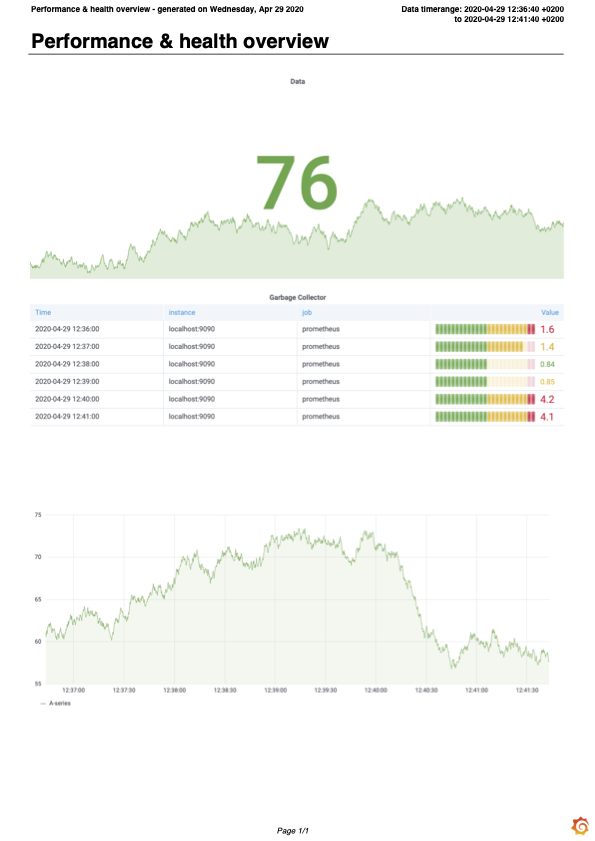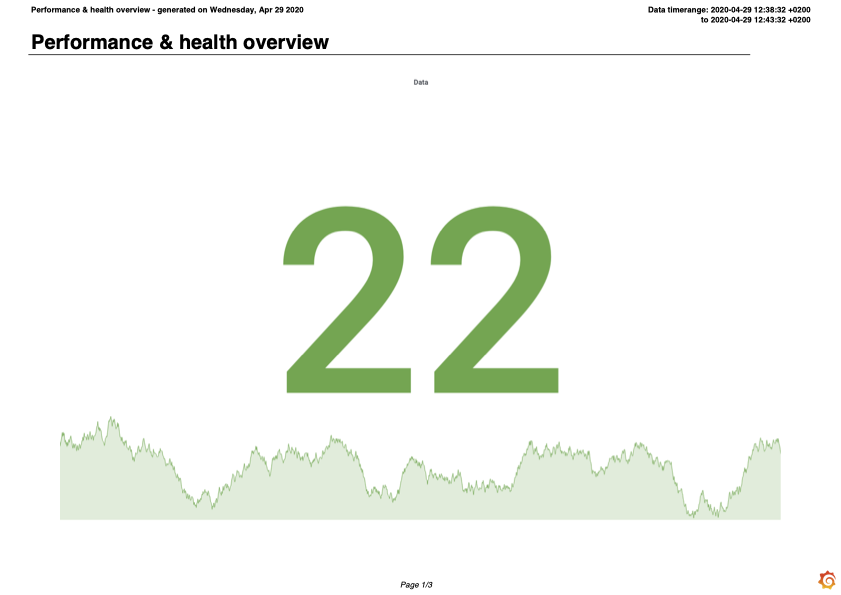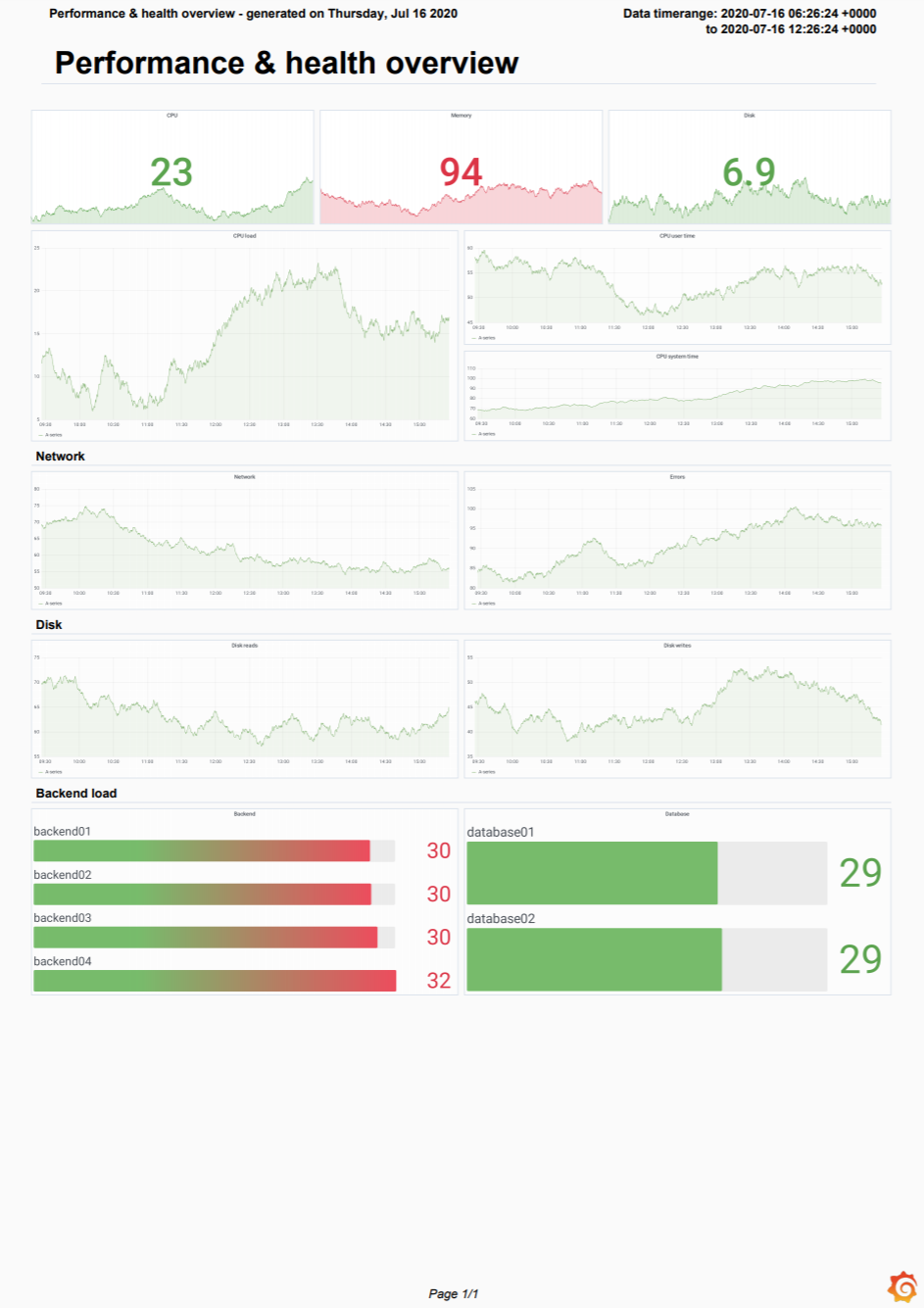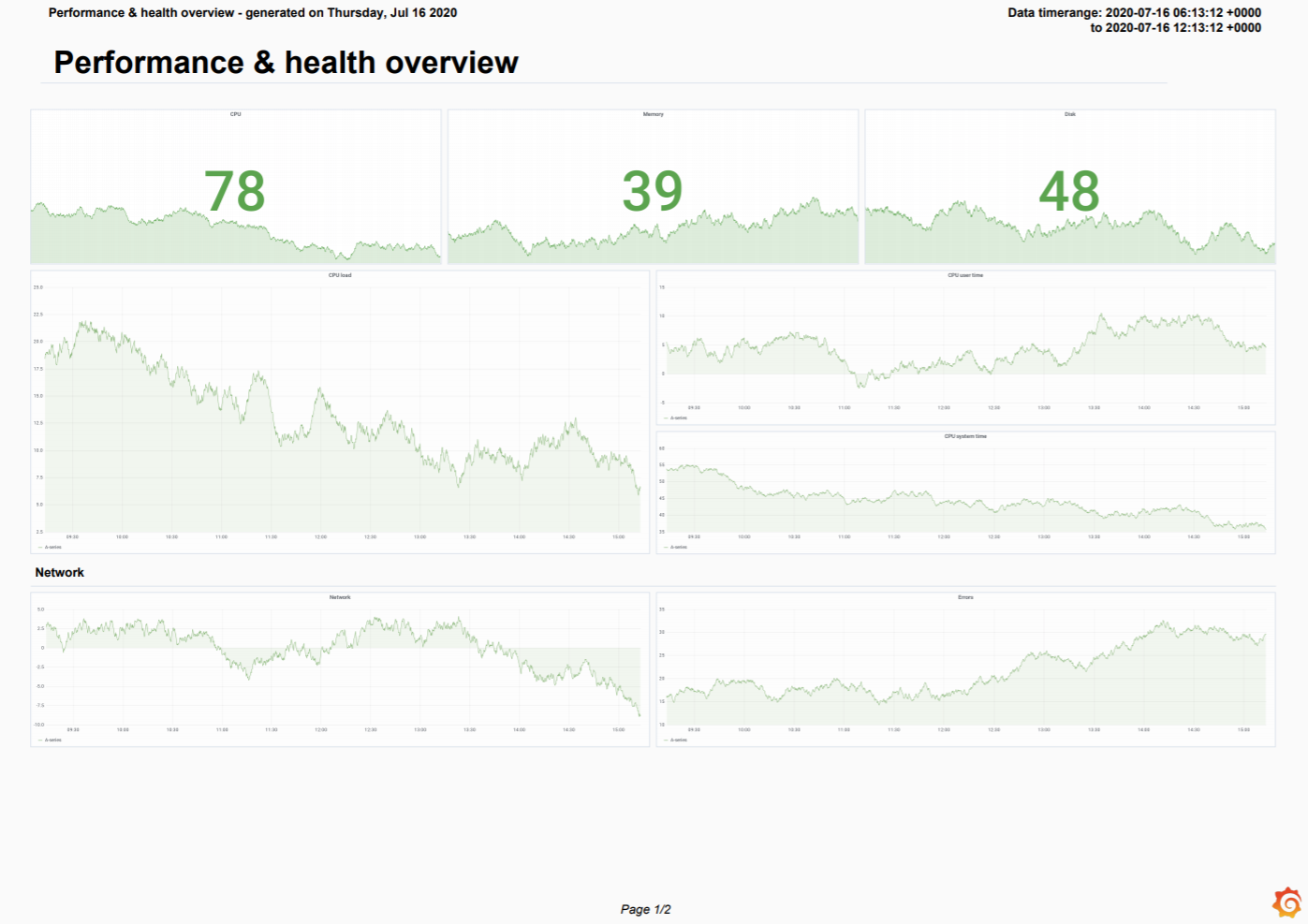Create and manage reports
Reporting allows you to send automated and scheduled emails from any of your dashboards. You can configure several elements of these reports and generate PDFs, CSV files, and embedded images. Any changes you make to a dashboard used in a report are reflected the next time the report is sent.
Requirements
For Grafana Enterprise, the Reporting feature has the following requirements:
- SMTP must be configured for reports to be sent. Refer to SMTP configuration documentation for more information.
- The Grafana image renderer plugin (v3.10+) must be installed or the remote rendering service must be set up. Refer to Image rendering for more information.
Rendering configuration
By default, attachments (PDFs, CSV files, and embedded images) larger than 10 MB are not sent, which keeps email servers from rejecting the email. You can increase or decrease this limit in the reporting configuration.
When a report file is generated, it’s temporarily written to the corresponding folder (csv, pdf, png) in the Grafana data folder.
A background job runs every 10 minutes and removes temporary files.
You can set how long a file should be stored before being removed by configuring the temp_data_lifetime setting in your ini file.
Access control
Only organization administrators can create reports by default. You can customize who can create reports with role-based access control (RBAC).
When RBAC is enabled, you need to have the relevant permissions to create and manage reports. Refer to specific guides to understand what permissions are required.
Create a report
The report creation process is multi-step, but you don’t need to complete these steps in order and you can skip steps by clicking a step name at the top of the page.
You can also save the report as a draft at any step in the process:

To create a report, follow these steps:
- In the main menu, click Dashboards > Reporting.
- Click + Create a new report.
- Complete the report steps, as needed:
- Click one of the following buttons in the top-right corner of the screen:
- Send now or Schedule send - The report is sent according the schedule you’ve set.
- Save as draft - You can save a draft at any point during the report creation or update process, even if it’s missing required fields. The report won’t be sent according to its schedule while it’s a draft.
- Discard - Delete the report draft. This action can’t be reversed.
1. Select dashboard
At this step, select the dashboard or dashboards on which the report is based, as well as the variables and time ranges for those dashboards. The options are:
Template variables
This option is only displayed if the dashboard has variables.
You can configure report-specific template variables for the dashboard on the report page. The variables that you select override the variables from the dashboard. For detailed information about using template variables, refer to Variables.
The query variables saved with a report might become out-of-date if the results of that query change. For example, if your template variable queries for a list of hostnames and a new hostname is added, then it won’t be included in the report. If that occurs, the selected variables must be manually updated in the report. If you select the All value for the template variable or if you keep the dashboard’s original variable selection, then the report stays up-to-date as new values are added.
Time range
If you leave the Time range field empty, reports use the saved time range of the dashboard. Optionally, you can change the time range of the report by setting it in the Time range field. If specified, the custom time range overrides the time range from the report’s dashboard.
The page header of the report displays the time range for the dashboard’s data queries.
Report time zones
Reports use the time zone of the dashboard from which they’re generated. You can control the time zone for your reports by setting the dashboard to a specific time zone. Note that this affects the display of the dashboard for all users.
If a dashboard has the Browser Time setting, the reports generated from that dashboard use the time zone of the Grafana server. As a result, this time zone might not match the time zone of users creating or receiving the report. If you want to use a specific time zone, save the dashboard with a fixed time zone instead of Browser Time
Each dashboard’s time zone setting is visible in the time range controls.
2. Format report
At this step, select one or more report formatting options. You can select multiple options, but you must select at least one:
- Attach the report as a PDF
- Include table data as PDF appendix (Public preview only)
- Embed a dashboard image in the email
- Attach a CSV file of the table panel data
- Attach a separate PDF of table data (Public preview only)
Attach the report as a PDF
If you selected the PDF format option under the Style the PDF section, you can configure the following options:
Configure multiple PDFs - Click the Combine all dashboard PDFs in one file checkbox if you want to generate one PDF file for all the dashboards included in the report. This option is only displayed if your report includes multiple dashboards.
Configure report header - Click the Show template variables checkbox to show dashboard variables.
Orientation - Set the report orientation in Portrait or Landscape. Refer to the Layout and orientation table to see examples.
Layout - Select one of the following:
Simple - Renders each panel as full-width across the PDF.
Grid - Renders the PDF with the same panel arrangement and width as the source dashboard.
Refer to the Layout and orientation table to see examples.
Zoom - Zoom in to enlarge text in your PDF, or zoom out to see more data (like table columns) per panel.
Click Preview PDF in the top-right corner of the screen to view a rendered PDF with the options you selected.
Layout and orientation
Embed a dashboard as an image in the email
You can send a report email with an image of the dashboard embedded in the email. This lets the email recipients see the dashboard at a glance.
Attach a CSV file of the table panel data
You can attach a CSV file to the report email for each table panel on the selected dashboard.
Click Download CSV in the top-right corner of the screen to download a zipped file of the CSV files for your selected dashboard.
Table data in PDF
Note
Available in public preview (pdfTablesfeature toggle) in Grafana Enterprise v10.3+ with the Grafana image renderer plugin v3.0+, as well as in Grafana Cloud.
When there’s more data in your table visualizations than can be shown in the dashboard PDF, you can select one of these two options to access all table visualization data as PDF in your reports:
- Include table data as PDF appendix - Adds an appendix to the dashboard PDF.
- Attach a separate PDF of table data - Generates a separate PDF file.
3. Schedule
At this step, set scheduling information. Options vary depending on the frequency you select.
4. Share
At this step, enter information related to sharing the report:
Click Send test email in the top-right corner of the screen to verify that the configuration works as expected and to verify that emails are working. You can choose to send this email to the recipients configured for the report, or to a different set of email addresses only used for testing.
5. Confirm
At this step, the confirmation page displays all the report settings. Review them and confirm that they’re correct or click the provided Edit links for each section to make updates.
Then, click Send now or Schedule send.
You can also save the report as a draft or discard it. Discarding the report is irreversible.
Send a report using the API
You can send reports programmatically with the send report endpoint using the HTTP API.
Manage reports
On the Reports page, you can view and manage your existing reports or create new ones.

Edit reports
To edit a report, follow these steps:
- In the main menu, click Dashboards > Reporting.
- Click the row of the report you want to update.
- Click the Edit report button in the top-right hand corner or click the Edit link for a specific section to go to that one directly.
- When you’ve finished making changes, click Confirm at the top of the screen to go to the last step.
- Click Update report.
Pause or resume reports
You can pause and resume sending reports from the report list view. To do this, follow these steps:
In the main menu, click Dashboards > Reporting.
On the row of the report you want to update, do one of the following:
- Click the pause icon - The report won’t be sent according to its schedule until it’s resumed.
- Click the resume icon - The report resumes on its previous schedule.
Delete reports
To delete a report, follow these steps:
- In the main menu, click Dashboards > Reporting.
- On the row of the report you want to update, click the trash can icon.
- Click Delete to confirm.
Deleting a report is irreversible.
Troubleshoot Reporting
To troubleshoot and get more log information, enable debug logging in the configuration file. Refer to the log filters configuration documentation for more information.
[log]
filters = rendering:debug,report.api:debug,report.render:debug,report.scheduler:debug,report.sender:debug,report.service:debug






